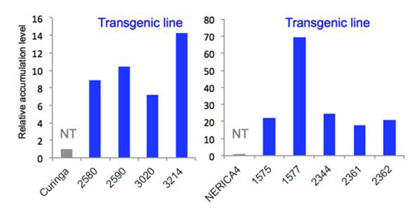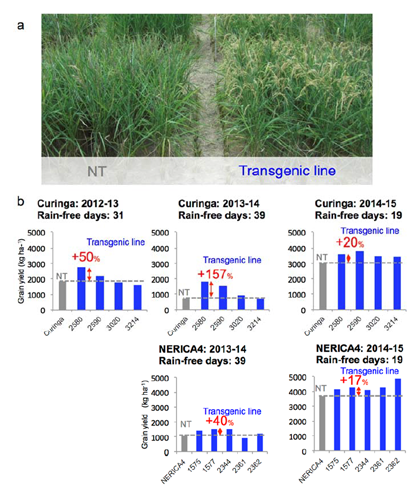Overexpression of AtGolS2, an Arabidopsis galactinol synthase gene, increases grain yield in rice under drought stress in the field
Description
Drought is a major abiotic stress, critically limiting the yield of food crops including rice. Many reports have demonstrated that overexpression of stress-related genes could improve drought tolerance in rice. However, very few reports have shown improved grain yields in transgenic rice under drought conditions in field environments. Many genes that may play an important role under drought have been mostly introduced in a single model variety of rice, such as Nipponbare, to understand the functions of the genes. To improve rice varieties by transgenic approaches, it is necessary to consider both adaptation to the target environments and fulfillment of local grain quality and of taste preferences. Here, we describe the generation of transgenic rice lines that overexpress AtGolS2, which is a candidate gene for drought tolerance encoding a galactinol synthase identified in Arabidopsis, in the background of two commercial varieties, and present the increased grain yield of transgenic rice under drought in the field.
We generated transgenic rice lines that express AtGolS2 in two varieties, Curinga and NERICA4. Curinga is a Brazilian local upland rice variety, and NERICA4 is a popular upland rice variety in African countries. Each transgenic line accumulated significantly higher amounts of galactinol as compared with non-transgenic rice plant (Fig. 1). The transgenic lines grown under drought had higher relative water content in leaves and higher photosynthetic activity than non-transgenic plants, leading to lesser reduction in plant growth. To test the performance of the transgenic lines under drought in the field, three consecutive field trials were carried out from 2012 to 2015. The extent of drought varied among trial years. For instance, trial years 2012-13 and 2013-14 were very dry with continuous rain-free days of 31 and 39, respectively, including flowering periods. Rain-free days in trial year 2014-15, however, were only 19 after flowering. A transgenic Curinga line numbered 2580 and a transgenic NERICA4 line numbered 1577 consistently had higher grain yield than each non-transgenic variety (Fig. 2). Our results provide strong evidence that AtGolS2 is a useful biotechnological tool to reduce grain yield losses in rice under drought in the field.
For commercialization of the transgenic lines developed in this study, multi-location trials in South America and Africa are required, and the laws and ordinances of each country related to the treatment of genetically modified organisms have to be followed. For dissemination, collaboration with international and local institutes and with private sectors is required.
Figure, table
-
Fig. 1. Accumulation of galactinol in transgenic lines for AtGolS2. Numbers indicate ID for each transgenic line. NT, non-transgenic plants.
-
Fig. 2. Improved grain yields of transgenic lines for AtGolS2 under drought in the field.
(a) Evaluation of transgenic rice in a confined field of International Center for Tropical Agriculture located in Colombia. Left, non-transgenic Curinga; right, transgenic lines of Curinga numbered 2580. (b) Grain yield of transgenic lines for AtGolS2 in the three consecutive field trials. Numbers indicate ID for each transgenic line. NT, non-transgenic plants.
- Affiliation
-
Japan International Research Center for Agricultural Sciences Biological Resources and Post-harvest Division
Japan International Research Center for Agricultural Sciences Tropical Agriculture Research Front
- Research project
- Program name
- Term of research
-
FY2017(2013~2017)
- Responsible researcher
-
Ishizaki Takuma ( Tropical Agriculture Research Front )
Ogata Takuya ( Biological Resources and Post-harvest Division )
Maruyama Kyounoshin ( Biological Resources and Post-harvest Division )
Nakashima Kazuo ( Biological Resources and Post-harvest Division )
KAKEN Researcher No.: 90343772Ishitani Manabu ( International Center for Tropical Agriculture )
Selvaraj Michael ( International Center for Tropical Agriculture )
Kusano Miyako ( University of Tsukuba )
KAKEN Researcher No.: 60415148Takahashi Fuminori ( RIKEN )
KAKEN Researcher No.: 00462698Shinozaki Kazuo ( RIKEN )
KAKEN Researcher No.: 20124216 - ほか
- Publication, etc.
-
https://doi.org/10.1111/pbi.12731
Selvaraj M et al. (2017) Plant Biotechnology Journal, 15 (11): 1465-1477
- Japanese PDF
-
A4 352.78 KB
A3 349.2 KB
- English PDF
-
A4 258.51 KB
A3 175.66 KB
- Poster PDF
-
2017_B07_poster.pdf409.45 KB


